
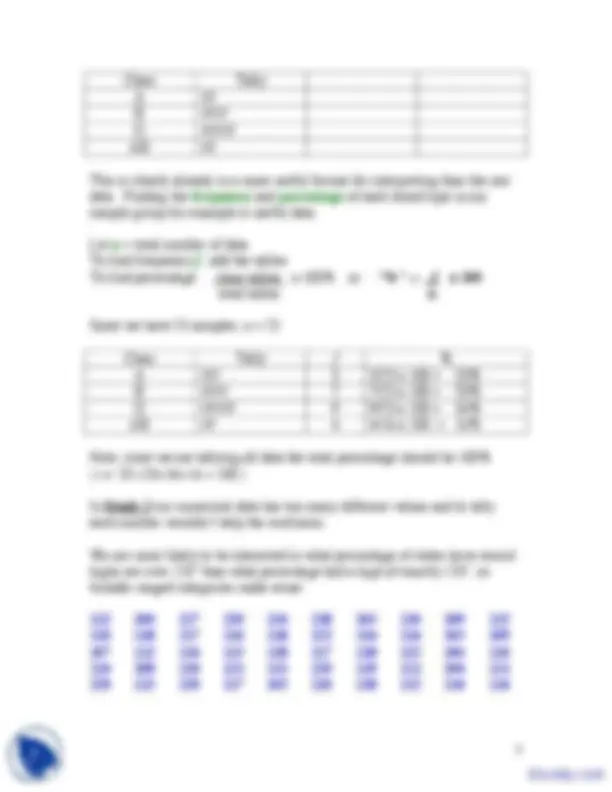
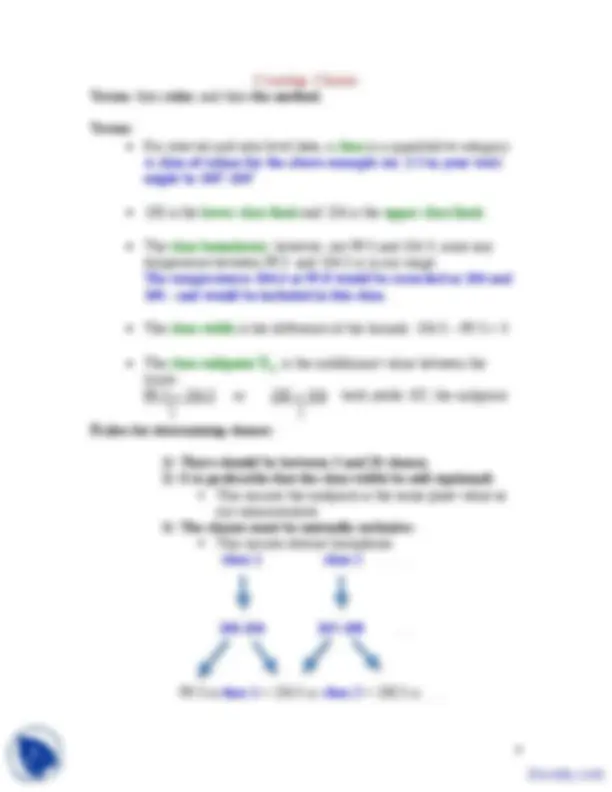
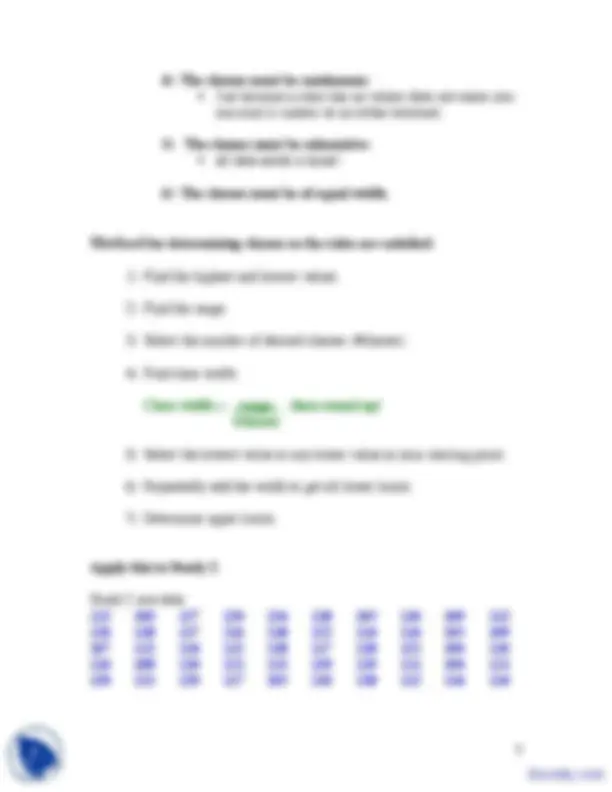

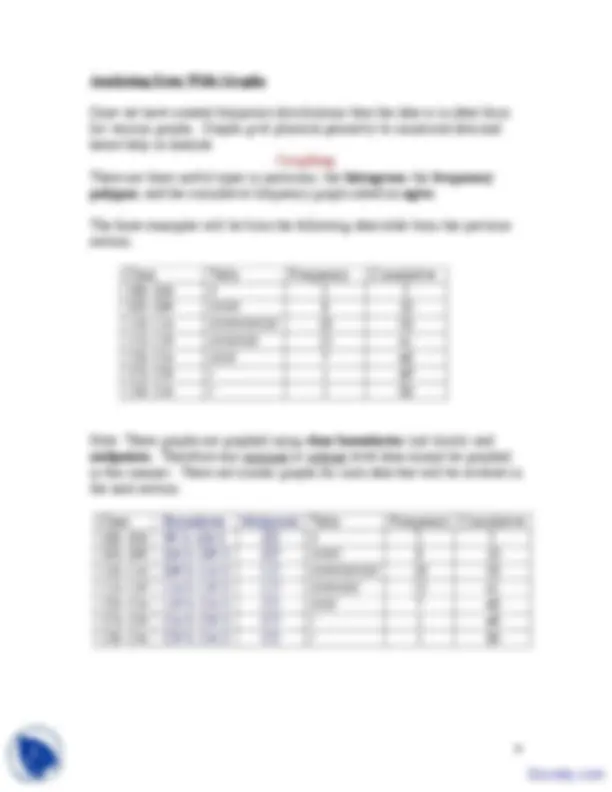
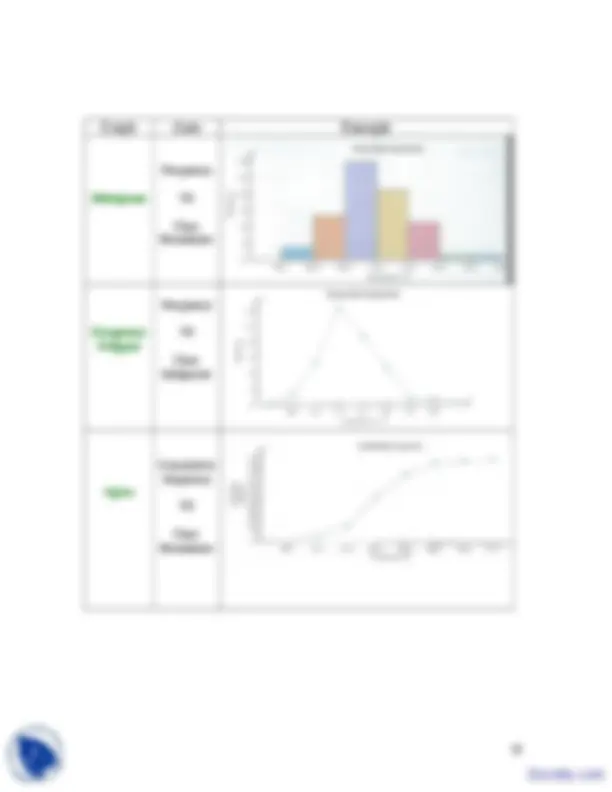
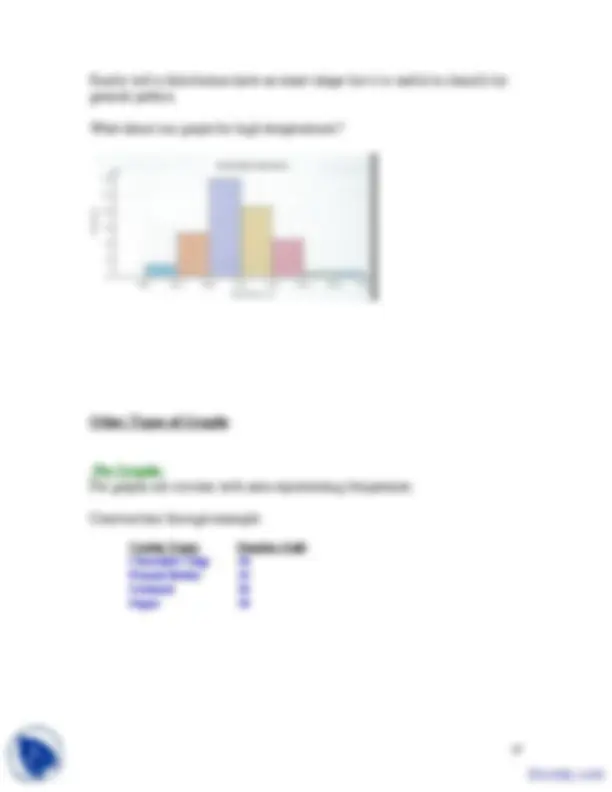
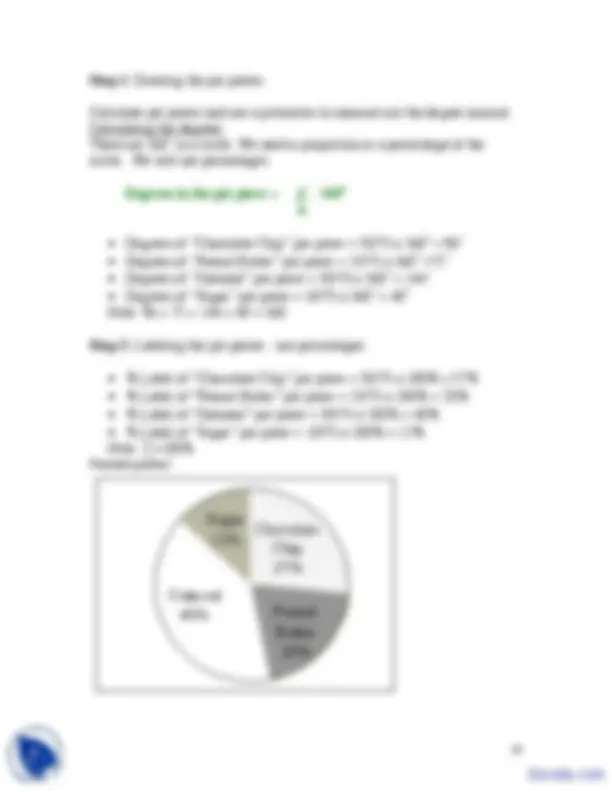
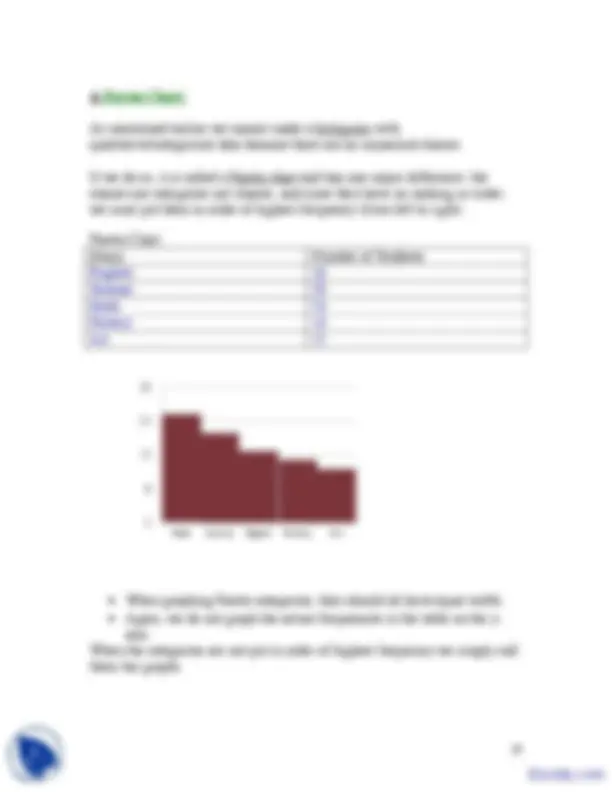
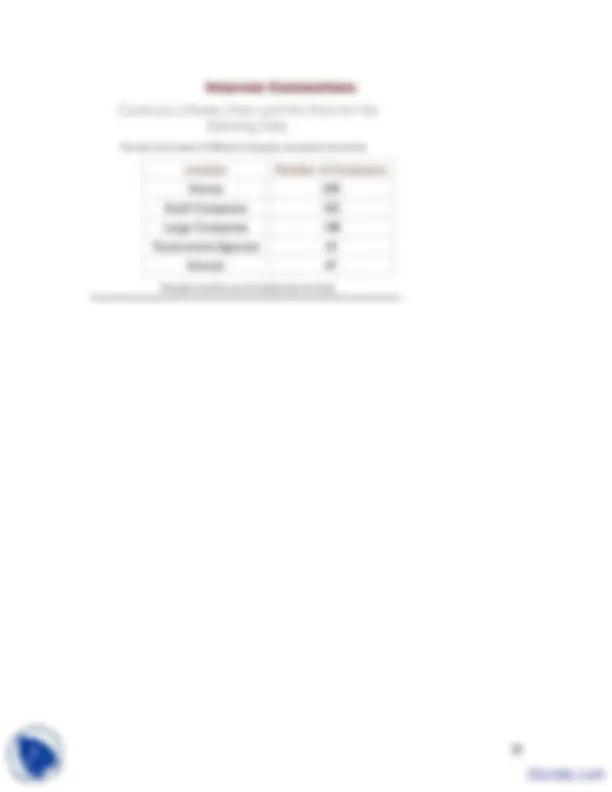
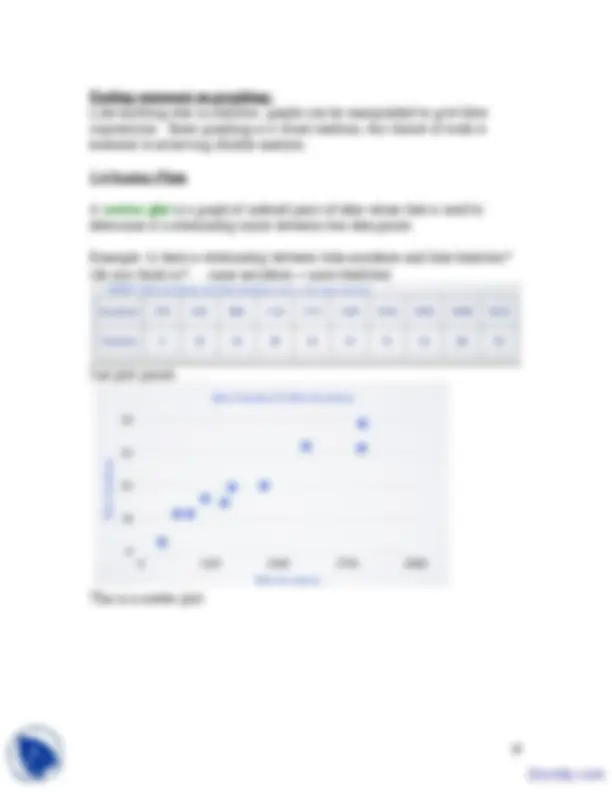
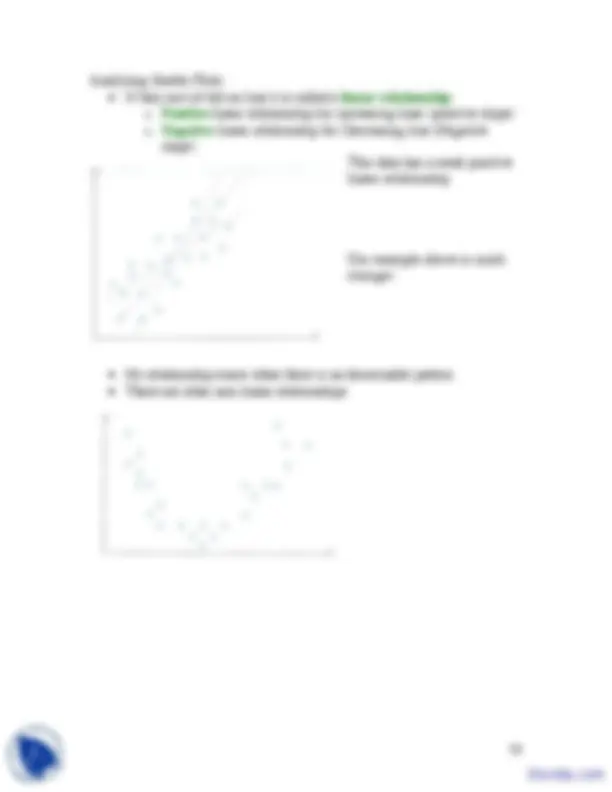


Study with the several resources on Docsity

Earn points by helping other students or get them with a premium plan


Prepare for your exams
Study with the several resources on Docsity

Earn points to download
Earn points by helping other students or get them with a premium plan
Community
Ask the community for help and clear up your study doubts
Discover the best universities in your country according to Docsity users
Free resources
Download our free guides on studying techniques, anxiety management strategies, and thesis advice from Docsity tutors
Organizing Data, Graphing, Raw data, Classes, Frequency distribution, Classes and Frequencies, Percentage, Creating Classes, Rules for determining classes, Constructing a frequency Distribution are learning points available in this lecture notes.
Typology: Study notes
1 / 20

This page cannot be seen from the preview
Don't miss anything!













1
Introduction:^ Organizing Data & Graphing When data are collected they are called raw data Raw Data are frequently large, very messy and hard to interpret: (^21119 18294 922 395 856 518 16720 5196 5116 11512 197 191 147 3129 591 2185 134 8518 ) (^231 2211 09 51 44 15 69 61 49 714 62 17 96 130 146 71 29 65 ) To help us organize the mess we can: 1) Separate it into hopefully meaningful classes
2
For classes. Using these classes as we use categories, we can create a frequency distribution interval and ratio level data we must create our own categories called. The only time we do not group data into classes is grouped in extremely small samples where each data can be its own class. Two studies show the difference: Study 1: 25 students do a blood drive Variable Data : ________: blood type________________ Raw data: A O (^) OB BB ABAB OB AB^ B^ A^ OBA^ OOO^ OAB ABOA Study 2: US record high temperature for 50 states Variable Data : ________________________: Record High Raw Data: (^112110 100118 127117 120116 134118 118122 105114 110114 109105 ) (^107116120 112108113 114110120 115121117 118113105 117120110 118119118 122111112 106104114 ) Since (we call frequency. Study 1 classe (^) s has nominal level data, we already have qualitative categories) to count frequency. We simply need to tally to find the Raw data: A O (^) OB BB ABAB OB AB^ B^ A^ OBA^ OOO^ OAB ABOA
4
Terms , then rules , and then the method.^ Creating^ Classes Terms: • For interval and ratio level data, a A class of values for the above example (ex. 2 class is a quantitative category. - 3 in your text)
-^ might be 100 100 is the lower class limit˚-104˚ and 104 is the upper class limit.
1) 2) There should be between 5 and 20 classes.It is preferable that the class width be odd (optional) This insures the midpoint is the same place value as 3) The classes must be mutually exclusive: our measurements:This insures distinct boundaries class 1 class 2..... 100 - 104 105 - 108... 99.5 ≤ class 1 < 104.5 ≤ class 2 < 108.5 ≤....
5
4) The classes must be continuous: Just because a class has no valu can omit it (unless its on either extreme).es does not mean you 5) The classes must be exhaustive: all data needs a home! 6) The classes must be of equal width.
7
Class 100105 - - 104109 Tally///////// (^) / Frequency 28 Cumulative 102 110115120 - -- 114119124 ////////////////////////////////////// 18137 284148 125130 - - 129134 // (^11 ) Cumulative is useful: From such distributions we will next learn to analyze by: 41 of 50 states have high temperatures under 120˚.
10
Graph Axes Example Histogram^ Frequency Class VS Boundaries
Frequency Polygon^ Frequency Class VS Midpoints Ogive^ Cumulative^ frequency VS Boundaries^ Class
11
Draw and label axes with^ Steps^ Graph frequency on the y each class boundary on the x axis. -axis and plot-
Draw a vertical bar for each class with the class frequency as the height.
Draw and label axes with frequency on the y plot the class midpoints on the-axes and x 2) Plot points for each class:-axis. (midpoint, frequency). 3) Connect the dots.
Draw and label axes with Cumulative frequency on the y axes and plot the class - boundaries on the x 2) Plot points for each class:-axis. (upper class boundary, cumulative freq frequency).
Connect the dots.
13
Rarely will a distribution have an exact shape but it is useful to classify by general pattern. What about our graph for high temperatures?
Other Types of Graphs Pie graph^ Pie Graphs s are circular with area representing frequencies.: Construction through example: Cookie Types Number Sold Chocolate Chip Peanut Butter Oatmeal 201530 Sugar 10
14
Step 1 Calculate pie pieces and use a protractor to: Drawing the pie pieces. measure out the degree amount. Calculating the degrees: There are 360 circle. We will use percentages.˚ in a circle. We need a proportion or a percentage of the Degrees in the pie piece = (^) n f****. 360˚
16
Time Series Graph This type of graph represents data that occur over a specific period of time.: Axes: Variable of choice Vs Time Example time series graph data: A local fundraiser wants to graphically display the contributions they have received over the past five years Year 1996 Contributions $ 199719981999 $700$800$ 2000 $
17
Stem Stem and leaf plots are a method of organizing data that is a combination of sorting and graphing. and leaf plots: A stem and part of the data value as the leaf to form groups or c stem and leaf plot is a data plot that uses part of the data value as thelasses. Explanation through example: Data: 12, 22, 22, 24, 34, 31, 26, 35, 27, 39, 49, 10 45, 36, 23, 16, 37, 28, 18, 13, 10, 23, 30, 31 Step 1: Arrange the data in order. 10, 10, 12, 13, 16, 18, 22, 22, 23, 23, 24, 26, 27, 28, 30, 31, 31, 34, 35, 36, 37, 39, 45, 49, Step 2: Separate into groups by first digit. 10, 10, 12, 13, 16, 18 22, 22, 23, 23, 24, 26, 27, 28 30, 31, 31, 34, 35, 36, 37, 39 45, 49 Step 3: 12 02 02 The leading digit is the “stem” and the trailing digit is the “leaf”: (^23 33 64 86 7 ) 34 05 19 1 4 5 6 7 9
19
Ending comment on graphing: Like anything else in statistics, graphs can be manipulated to give false impressions. Since graphing is a visual medium, fair choice of scale is essential to achieving reliable analysis. 2.4 Scatter Plots A determine if a relationship exists between two data points. scatter plot is a graph of ordered pairs of data values that is used to Example: Is there a relationship (do you think so?.. ..more accidents = more fatalities) between bike accidents and bike fatalities?
Just plot points... ..
. This is a scatter plot.
20
Analyzing Scatter Plots: • If they sort of fall on line it is called a o Positive linear relationship for increasing lines (positive slope) linear relationship o Negative slope) linear relationship for Decreasing line (Negative This data has a weak positive linear relationship Our example above is much stronger